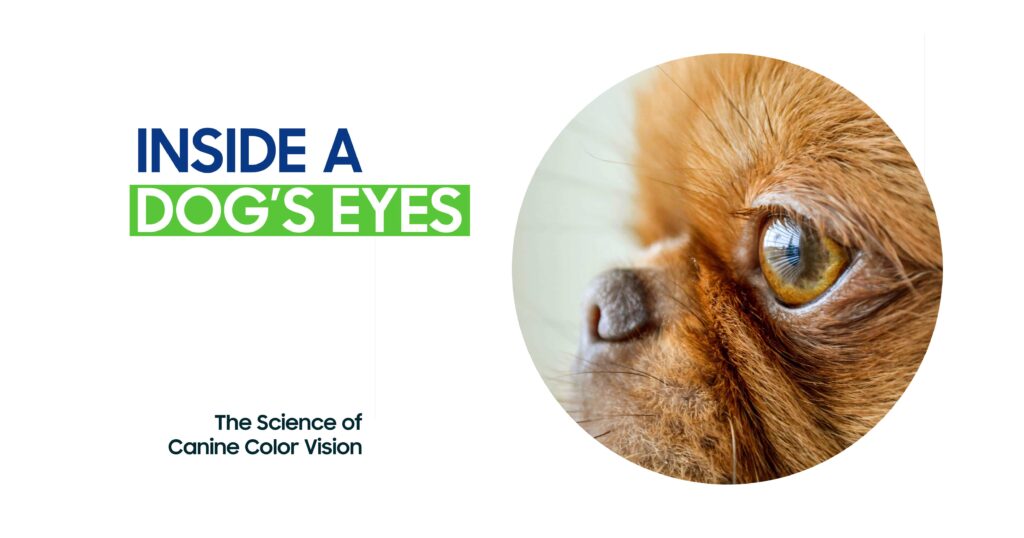Dogs experience the world in a way that’s quite different from humans. One of the biggest myths about dog vision is that they see everything in black and white. But is this true? What colors can dogs see, and how does their world compare to ours? If you’ve ever wondered what dogs see, this post will take a deep dive into the dog color spectrum, busting myths and answering questions like Can dogs see red, and how many colors can dogs see? Let’s step into their world!
How Dogs See the World
Have you ever tossed a bright red ball to your dog, only to watch them struggle to find it in the grass? It’s not because your pup has poor eyesight. Dog vision processes colors differently than ours.
Dogs rely more on motion and contrast than color when recognizing objects. Their eyes are structured to detect movement quickly, making them excellent hunters. But when it comes to color, their world is not as rich and varied as ours.
Imagine walking through a park on a sunny day. While we see bright green grass, red flowers, and blue skies, our dogs see things in a much more muted spectrum. So, can dogs see color? Absolutely, but their experience of color is different from ours.
Can Dogs See Color or Only in Black and White?
Many believe dogs see in shades of gray, but that’s a misconception. While they don’t see colors like humans, they are not entirely colorblind.
The Science Behind Dog Vision
The reason for the difference in dog vision lies in the structure of their eyes. Human eyes have three types of color-detecting cells (cones) that allow us to see a full spectrum of colors – red, blue, and green. Dogs, however, have only two types of cones, making them dichromatic (two-color vision). This means they see shades of blue and yellow but struggle to distinguish between red and green.
Think of a colorblind person who can’t tell the difference between red and green traffic lights – this is similar to how dogs experience color. Their world is not black and white but primarily made up of shades of blue, yellow, and gray.
How Many Colors Can Dogs See?
If dogs are dichromatic, how does that affect the dog color spectrum? How many colors can dogs see? The answer is two – blue and yellow. Anything outside this range appears as a dull shade of gray or brown.
The Dog Color Spectrum Vs. Human Vision
Here’s a simple comparison of how colors look to dogs vs. humans:
- Blue. Dogs can see blue very clearly.
- Yellow. It is another easy color for dogs to recognize.
- Red and Green. These colors appear as shades of gray or brown.
- Purple. Dogs may see purple as a type of blue.
- Orange. It likely looks like a dull yellow.
So, when choosing toys, blue and yellow will stand out the most to your dog. A red ball in green grass? To them, it might blend into the background!
Can Dogs See Red, or Is It Just a Myth?
One of the biggest questions for dog owners is, can dogs see red? The answer is no – not in the way we do. To dogs, red appears as a muted brownish-gray. This is because their eyes lack the red-sensitive cones that humans have.
What Colors Stand Out Most to Dogs?
Since dogs struggle with red and green, they rely on contrast and brightness to differentiate objects. Blue and yellow are the two most vibrant colors in a dog’s world, so a blue frisbee will be much easier for them to spot than a red one. If you’re picking out toys or training tools, opt for blue or yellow to ensure they stand out!
How Dog Vision Affects Their Daily Life
Understanding dog vision helps us better cater to their needs. From playtime to training, knowing what colors dogs can see allows us to make better choices in their daily environment.
Choosing the Right Toys and Training Tools for Your Dog
Since dogs see blue and yellow best, consider these options:
- Best Toy Colors. Bright blue and yellow toys are the easiest for them to find.
- Worst Toy Colors. Red, green, and brown may blend into the surroundings.
- Training Aids. If you’re using colored targets for training, blue or yellow markers will be more visible to your dog.
Making simple adjustments based on the dog’s color spectrum can significantly improve your dog’s ability to recognize objects, play fetch, and respond to training cues.
Seeing the World Through Your Dog’s Eyes
Understanding dog vision allows us to make their world more transparent and enjoyable. Whether picking the right-colored toys, designing a dog-friendly space, or simply appreciating how they see us, knowing what dogs see helps us become better pet parents. So next time you’re at the pet store, remember: Blue and yellow are your dog’s best friends!
Curious About Your Dog’s Vision? Vet Today Can Help
While dog vision is fascinating, monitoring your pet’s eye health is essential. If your dog frequently bumps into objects, hesitates in dim lighting, or has cloudy eyes, it might be time for a check-up.
Vets can detect early signs of vision problems and guide you on maintaining your dog’s eye health. Regular vet visits help ensure that your pup can continue seeing their world – no matter what colors they perceive!
FAQs
What colors do dogs see best?
Dogs see blue and yellow best. These colors stand out clearly in their vision.
What color do dogs avoid?
Dogs struggle with red and green, as these colors appear as shades of gray or brown.
How does a dog see a tennis ball?
If the ball is yellow, they can spot it quickly! But if it’s red or green, it may not stand out.
Do dogs see better in the dark than humans?
Yes! Dogs have more rod cells in their eyes, making them excellent at seeing in low-light conditions.
How does a dog’s vision compare to other animals?
Dogs have better night vision and motion detection than humans but see fewer colors than birds, which have even more advanced color vision than us!






